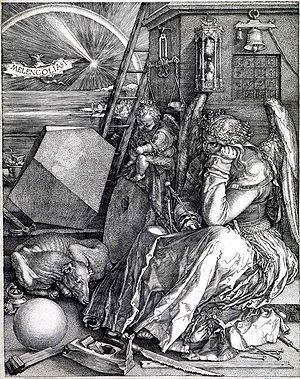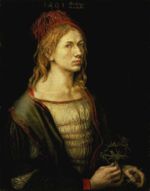- Melencolia I
-
Melencolia I 
Artist Albrecht Dürer Year 1514 Type engraving Dimensions 31 cm × 26 cm (12 in × 10 in) Melencolia I is a 1514 engraving by the German Renaissance master Albrecht Dürer. It is an allegorical composition which has been the subject of many interpretations. One of the most famous old master prints, it has sometimes been regarded as forming one of a conscious group of Meisterstiche with his Knight, Death and the Devil (1513) and Saint Jerome in his Study (1514).
Contents
Interpretations
The work has been the subject of more modern interpretation than almost any other print,[1] including a two-volume book by Peter-Klaus Schuster,[2] and a very influential discussion in his Dürer monograph by Erwin Panofsky.[3] Reproduction usually makes the image seem darker than it is in an original impression (copy) of the engraving, and in particular affects the facial expression of the female figure, which is rather more cheerful than in most reproductions. The title comes from the (archaically spelled) title, Melencolia I, appearing within the engraving itself. It is the only one of Dürer's engravings to have a title in the plate. The date of 1514 appears in the bottom row of the magic square, as well as above Dürer's monogram at bottom right. Suggestions that a series of engravings on the subject was planned are not generally accepted. Instead it seems more likely that the "I" refers to the first of the three types of melancholia defined by the German humanist writer Cornelius Agrippa. In this type, Melencholia Imaginativa, which he held artists to be subject to, 'imagination' predominates over 'mind' or 'reason'.
One interpretation suggests the image references the depressive or melancholy state and accordingly explains various elements of the picture. Among the most conspicuous are:
- The tools of geometry and architecture surround the figure, unused
- The 4 × 4 magic square, with the two middle cells of the bottom row giving the date of the engraving: 1514. This 4x4 magic square, as well as having traditional magic square rules, its four quadrants, corners and centers equal the same number, 34, which happens to belong to the Fibonacci sequence.
- The truncated rhombohedron[4] with a faint human skull on it. This shape is now known as Dürer's solid; over the years, there have been numerous articles disputing the precise shape of this polyhedron[5])
- The hourglass showing time running out
- The empty scale (balance)
- The despondent winged figure of genius
- The purse and keys
- The beacon and rainbow in the sky
- Mathematical knowledge is referenced by the use of the symbols: compass, geometrical solid, magic square, scale, hourglass.
Notes
- ^ Dodgson, Campbell (1926). Albrecht Dürer. London: Medici Society. pp. 94. "The literature on Melancholia is more extensive than on any other engraving by Dürer: that statement would probably remain true if the last two words were omitted."
- ^ Schuster, Peter-Klaus (1991). MELENCOLIA I: Dürers Denkbild. Berlin: Gebr. Mann Verlag. pp. 17–83.
- ^ Panofsky, Erwin; Klibansky, Raymond; Saxl, Fritz (1964). Saturn and melancholy. New York: Basic Books, Inc. http://quod.lib.umich.edu/cgi/t/text/text-idx?c=genpub;cc=genpub;q1=Klibansky;op2=and;op3=and;rgn=works;rgn1=author;rgn2=author;rgn3=author;view=toc;idno=0431529.0001.001.
- ^ Weisstein, Eric W.. "Dürer's Solid". Wolfram MathWorld. http://mathworld.wolfram.com/DuerersSolid.html. Retrieved 2008-04-21.
- ^ Weitzel, Hans. A further hypothesis on the polyhedron of A. Dürer, Historia Mathematica 31 (2004) 11
References
- Brion, Marcel. Dürer. London: Thames and Hudson, 1960
- Nürnberg, Verlag Hans Carl. Dürer in Dublin: Engravings and woodcuts of Albrecht Dürer. Chester Beatty Library, 1983
- Ewald Lassnig, Dürers "MELENCOLIA-I" und die Erkenntnistheorie bei Ulrich Pinder; in: Wiener Jahrbuch für Kunstgeschichte, 2008, S. 51-95
- Ernst Th. Mayer: Melencolia § I – der "angelo terrestre" und sein gleichzeitiges doppeltes Sehvermögen. Befunderhebung aufgrund der visuellen Geometrie von Dürers verschlüsseltem Selbstbildnis (1514). In: Musik-,Tanz- und Kunsttherapie, Vol. 20, 2009, Nr. 1, S. 8–22.
External links
- Wake Forest University - Article on the use of symbolism in Melancholia I
- [1]- Additions and diverging definitions including a video of Dürer's Solid
Albrecht Dürer Paintings Portrait Diptych of Dürer's Parents (1490) · Portrait of Dürer's Father at 70 (1497) · Haller Madonna (c. 1498) · Lamentation of Christ (attributed, c. 1498) · Portrait of Oswolt Krell (1499) · Portrait of Elsbeth Tucker (1499) · Seven Sorrows Polyptych (c. 1500) · Lamentation of Christ (c. 1500) · Bagnacavallo Madonna (before 1505) · Christ among the Doctors (1506) · Portrait of a Young Venetian Woman (1505) · Feast of the Rosary (1506) · Avarice (1507) · Praying Hands (c. 1508) · Adam and Eve (1507) · Martyrdom of the Ten Thousand (1508) · Life of the Virgin (1510-1511) · Portrait of Emperor Maximilian I (1519) · Portrait of a Man (1521 or 24) · Portrait of Bernhart von Reesen (1521) · Portrait of Saint Jerome (1521) · The Four Apostles (1526) · Portrait of Hieronymus Holzschuher (1526) · Portrait of Jakob Muffel (1526)
Self-portraits Self-Portrait at the age of 13 (drawing, 1484) · Self-Portrait c 1492 (drawing, 1492) · Self-Portrait (1493) · Self-portrait at 26 (1498) · Self-Portrait at 28 (1500)Still life / nature View of Arco (1495) · Three Linden Trees (c. 1494) · The House by the Pond (c 1497) · Young Hare (1502) · Little Piece of Turf (1502) · Great Piece of Turf (1503) · Wing of a Roller (1512) · Rhinoceros (1516)Woodcuts / engravings The Child Jesus Holding the Globe (1493) · Dürer's Wife Anges (1494) · The Muse Thalia (1495/96) · Angel with a Lute (1497) · Apocalypse (1498) · Saint Michael Fighting the Dragon (1498) · The Four Witches (1497) · The Sea Monster (1498-1500) · Saint Sebastian at the Column (1500) · Visitation (1503) · Joachim and Anne Meeting at the Golden Gate (1504) · Knight, Death and the Devil (1513) · Melencolia I (1514) · Saint Jerome in His Study (1514) · Triumphal Arch (1515) · Head of a Walrus (1514)Drawings Portrait of the artist's mother at the age of 63 (1514)Alterpieces The Jabach Alterpiece (c. 1500) · The Heller Alterpiece (c. 1508) · Adoration of the Trinity (1511)Categories:- Engravings
- Renaissance art
- 1514 works
- Dürer paintings and prints
Wikimedia Foundation. 2010.

